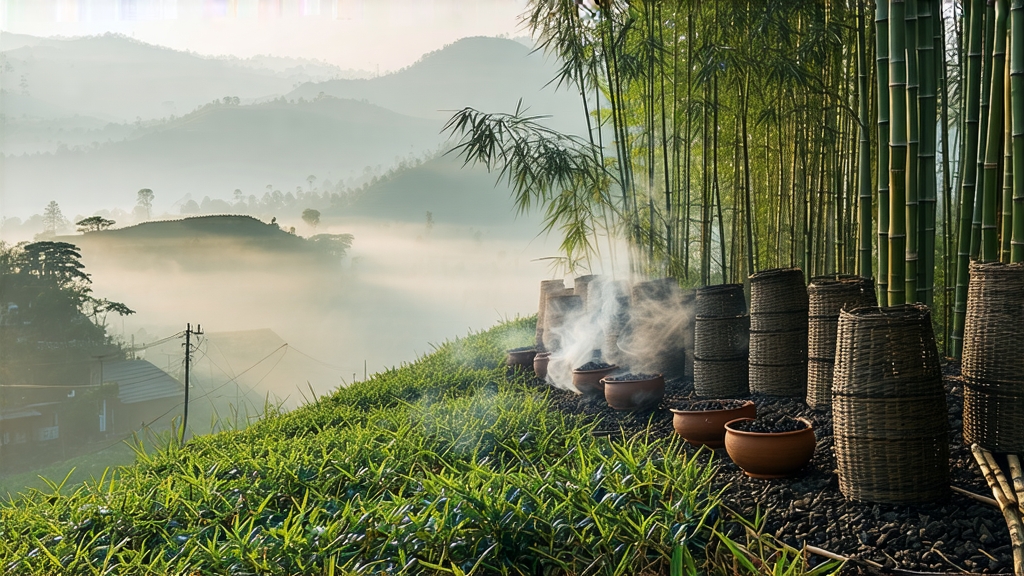
Ask most tea lovers to name a Chinese black tea and they will answer Keemun or perhaps Dian Hong; few realize that the very first black tea ever created was Lapsang Souchong, born in the cool gorges of the Wuyi Mountains in Fujian province. Its Chinese name, Zheng Shan Xiao Zhong, literally means “fine variety from the original mountain,” a reminder that authenticity is still measured by the micro-climate of Tongmu Guan, a protected gorge no wider than a rifle shot. In the 1640s, local growers developed deliberate oxidation to satisfy the export thirst of Dutch and British merchants; the leaf traveled from this fog-veiled canyon to London coffee houses where it was christened “bohea,” the anglicized pronunciation of “Wuyi.” For two centuries bohea was synonymous with black tea itself, and the pine-smoke note that once began as an accident of speed-drying became the signature that still divides opinion in every cup.
Today the name Lapsang Souchong hides two very different families. The export-style “smoked” version, still scented with fresh pinus taiwanensis resinous twigs, delivers campfire aromas that can fill a room. The “unsmoked” or “original” style, increasingly prized within China, foregoes the pine fire and instead reveals a mellow malt sweetness reminiscent of longan fruit and cinnamon. Both come from the same two cultivars—Xiao Zhong (small leaf) and Cai Cha (mixed colour)—yet diverge at the firing stage. A third, even rarer expression called “wild Lapsang” is picked from feral bushes seeded by birds at altitudes above 1,200 m; the leaves are tiny, almost moss green before oxidation, and infuse into a liquor the colour of antique amber with a cooling camphor finish.
Making Lapsang Souchong is a race between fragrance and fire. Picking starts at dawn in late April when two leaves and a bud still hold overnight dew. The leaves are first withered over glowing charcoal pans set to 28 °C; every ten minutes they are gently tossed by hand until the edges turn chestnut brown and the grassy volatiles blow away. Rolling follows, but unlike the brutal maceration applied to Ceylon leaf, Wuyi craftsmen use a light kneading motion that preserves the cell walls and keeps the liquor smooth. Oxidation is carried out in huge rattan baskets lined with wet cotton; the humidity is pushed to 85 % so that tannins polymerize slowly, giving the tea its characteristic raisin sweetness. The critical split occurs next. For smoked versions, the leaf is spread on multilayered bamboo trays suspended over fresh pine logs that have been set alight, extinguished, then rekindled so they smoulder rather than flame. The tea absorbs the smoke in three passes, each lasting no more than three minutes; too long and the aroma becomes acrid, too short and it fades within weeks. Unsmoked lots are instead baked at 80 °C in electric ovens that circulate air drawn from the surrounding fir forest, capturing a whisper of resin without the overt smoke. Finally every gram is hand-sorted to remove stems and yellow leaves, then rested for thirty days so the moisture equalizes and the flavour “settles.”
To brew Lapsang Souchong well, treat it like a shy guest: give it space, steady heat, and no sudden questions. A small 120 ml porcelain gaiwan or Yixing pot fired at high temperature works best because it holds warmth without adding clay flavours. Use 5 g of leaf—about two heaped teaspoons—and rinse for three seconds to wake the leaf; the first rinse already smells like a pine torch in winter. Follow with infusions of 5, 7, 10, 15 and 30 seconds using water at 90 °C; boiling water exaggerates the smoke and flattens the honey notes. The liquor runs from deep mahogany to glowing ruby, and if you pour each infusion into a glass fairness pitcher you will see the colour fade like a sunset. A gongfu session yields at least six steeps; the third is often the sweetest, when smoke steps back to reveal cocoa and dried longan. Alternatively, for European service, take 3 g per 250 ml cup, infuse four minutes at 85 °C, and add a slice of lemon